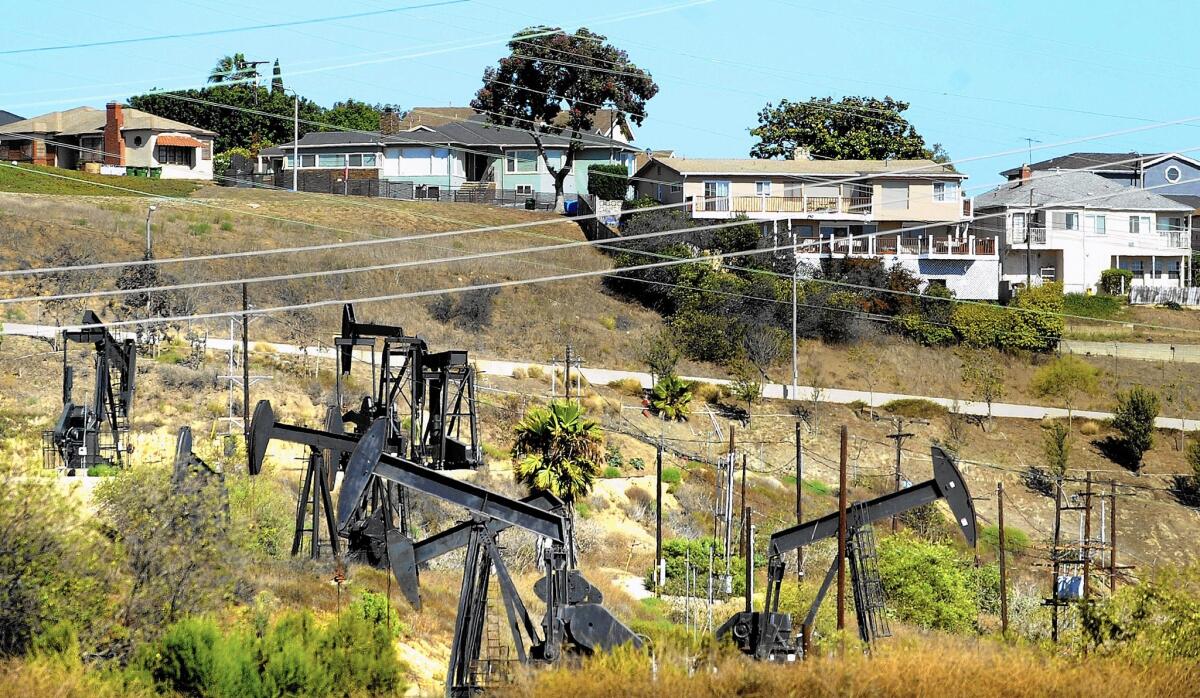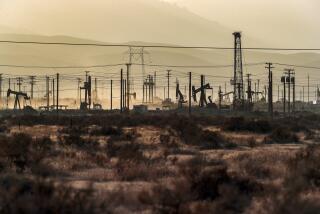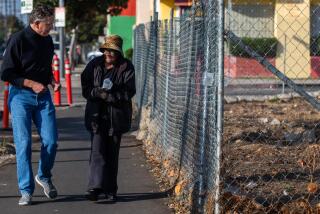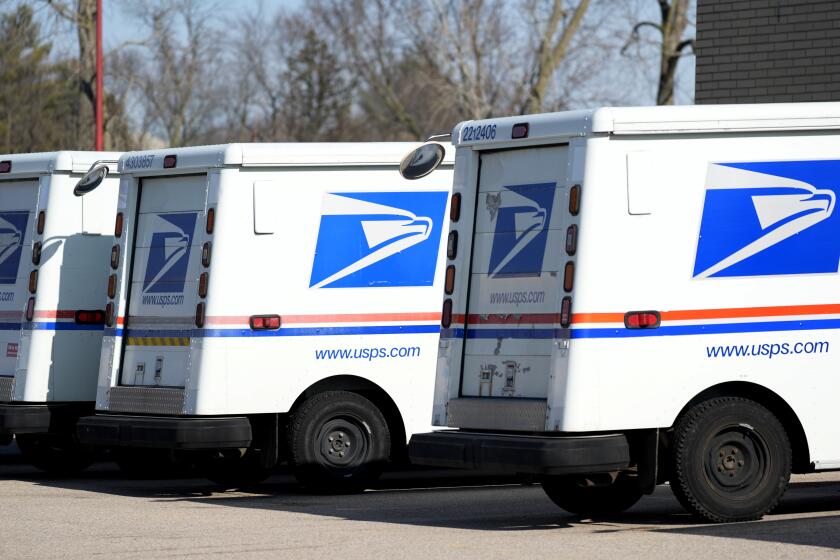Oil well oversight in L.A. Basin is ‘inconsistent,’ audit finds

Oils wells operate near homes and other residential areas in Los Angeles. A recent report finds lapses in oil well oversight pose a public health risk.
California’s oil regulatory agency concedes that it has allowed serious lapses in its monitoring of oil operations in the Los Angeles Basin, confirming long-standing fears of community activists who say that lax oversight puts Southern California neighborhoods at risk.
A report issued Thursday by the Division of Oil, Gas and Geothermal Resources found “inconsistent permitting, monitoring and enforcement of well construction and operation” in the agency’s Cypress office.
The internal audit concluded that:
• Since 2007, most oil projects in the L.A. area have not been subject to a required annual review.
• Seventy-eight percent of the projects in the audit did not undergo a required Area of Review, a comprehensive geologic and technical analysis of the oil field involved. Only five projects had undergone such an analysis in the last five years.
• Testing and methods to ensure that fluids injected into the ground don’t contaminate aquifers or drinking water sources are inadequate and need to be updated.
• Well records were often incomplete or missing. At least 47% of the files did not contain information about well casing that is vital to understanding the integrity of wells.
• To complete reports, regulators relied on self-reported information from operators rather than on information the agency could independently verify.
Steve Bohlen, state oil and gas supervisor, acknowledged that the report uncovered “systemic problems” but added that reforms he has instituted are proof that the troubled agency is trying to tighten its enforcement.
He said in a call with reporters that department investigators “dug deeply”’ through records and documents to assemble the audit.
“The division hasn’t owned up to its responsibility as a regulator in the past,” said Bohlen, who was hired in June. “We are rapidly moving toward doing that.”
The Los Angeles area is home to the nation’s largest urban oil field, with pump jacks and other industrial operations in residential neighborhoods, near schools and across from hospitals and retirement homes. Neighborhood activists have complained for decades about oil operations they say foul air and water and create endemic public health problems.
STAND-LA, an environmental justice coalition of community groups seeking to end oil drilling in neighborhoods, said in a statement that oil operations are putting communities in danger.
“It’s time for the city of Los Angeles and our state regulators to protect public health,” the statement said.
The California Council on Science and Technology in July warned of the risks posed by fracking and other oil operations in the state. Scientists expressed concerns about the density of oil wells and their proximity to humans in the Los Angeles Basin.
About 1.7 million people in Los Angeles live or work within one mile of an active oil or gas well, a report by the council said, and atmospheric concentrations of pollutants near those sites “can present risks to human health.”
The science report recommended an extensive epidemiological study of residents living near oil production sites. California does not regulate how close oil operations can be to residences, schools or hospitals. The report recommends that California adopt a setback requirement.
The Division of Oil, Gas and Geothermal Resources conducted its analysis to fulfill a legal requirement to report to the Legislature annually on oil and gas operations. The agency was chastised by elected officials last spring for failing to submit reports for several years.
Thursday’s document included charts showing great fluctuation from year to year in violations and enforcement actions. For example, state inspectors identified 323 unauthorized injections in 2012, but only 12 in 2013 and 17 the year after.
Bohlen explained the wide variances as changes in regulatory emphasis from year to year.
The state agency is also required by the Legislature to report on its Underground Injection Control program, which regulates more than 55,000 wells used to produce oil or inject oil field waste.
State officials are under fire from the U.S. Environmental Protection Agency for allowing companies to inject oil field waste and other fluids into aquifers protected under federal law. More than 2,500 illegal injection wells were identified around the state, although Bohlen said there were none in Los Angeles County.
He said the department’s ongoing investigation into potential risk to drinking water has led the agency to issue orders to close and seal 23 wells.
Catherine Reheis¿Boyd, president of the Western States Petroleum Assn., said the report represented “a new era of leadership and transparency, state regulators are now collecting and inventorying a huge amount of information from the state’s oil and gas producers and providing it for public review.”
The data from the Division of Oil, Gas and Geothermal Resources audit of the L.A. area were compiled more than a year ago, but Bohlen said it has taken time to write the report.
That delay angered environmentalists, who said it’s an example of the state promoting the interests of oil companies over public health.
“State officials endangered California’s drinking water by sitting on knowledge of this systemic failure of oil industry oversight for more than a year,” said Hollin Kretzmann, an attorney with the Center for Biological Diversity.
“The Brown administration kept these disturbing findings from the public and still hasn’t started taking corrective action,” Kretzmann said. “Regulators have let the oil industry virtually drill at will in the L.A. area, and those poorly regulated injection wells pose an enormous risk to underground water.”
More to Read
Start your day right
Sign up for Essential California for news, features and recommendations from the L.A. Times and beyond in your inbox six days a week.
You may occasionally receive promotional content from the Los Angeles Times.







